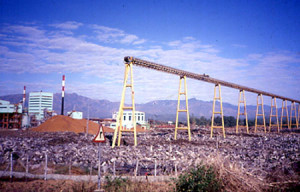By DESIREE CALUZA
 LACUB, Abra—This small village inhabited by Tingguians is known in the history of Abra as a tribal community that successfully fought the evils of human right atrocities under martial rule.
LACUB, Abra—This small village inhabited by Tingguians is known in the history of Abra as a tribal community that successfully fought the evils of human right atrocities under martial rule.
As they wage the fight today against large scale gold exploration in Lacub, they remember the anti-Cellophil struggle more than four decades ago.
In the 1970s, this town saw the transformation of faith among priests and youths who fervently fought for the defense of their ancestral domain against a logging company (the Cellophil Resources Company, or CRC) that destroyed not only the forests, but also agricultural farmlands in the province—the very source of life of the Tingguians in Abra. Never did the villagers expect that the priests would exchange their cassocks for guns, while the youths, one by one, were joining the underground revolution.
Every Cordillera Day on April 24, Igorots who attend the celebration recall the successful “anti-Cellophil struggle,” which to this day serves as an inspiration to indigenous peoples in that region to assert their right to ancestral domain. This story is often told alongside the anti-Chico Dam struggle and the martyrdom of a respected Kalinga pangat (chieftain) Macli-ing Dulag, who sparked a worldwide resistance to the dam project.
According to the Cordillera Peoples Alliance (CPA), Lacub was the center of the successful Tingguian resistance to the logging operations of the CRC under the Marcos dictatorship.
Lacub communities also played a crucial role in preventing various administrations from implementing then president Marcos’s plan to dam the Binongan river.
One of the priests who joined the New Peoples Army (NPA) was a young Catholic priest named Fr. Cirilo Ortega, who was then 27 years old. Ortega was serving as a parish priest of Malibcong town during the height of the Cellophil operation.
“When I look back at the history of the Cellophil struggle, we thought that joining the underground movement was a correct response; at that time it was a call of duty. It was a particular response to a particular situation,” Ortega said.
 “We listened to the voice of the people, and if the church people joined the underground, it was not only to oppose Cellophil. The oppression did not only happen in Abra, but in other parts of the country. It was an expression of faith to serve the poor,” he added.
“We listened to the voice of the people, and if the church people joined the underground, it was not only to oppose Cellophil. The oppression did not only happen in Abra, but in other parts of the country. It was an expression of faith to serve the poor,” he added.
Geraldine Fiag-oy, an anthropologist, recalled that Ortega and other priests had been conducting meetings to discuss the protests against the continuing operations of Cellophil. But she never thought that the priests were also planning to join the underground movement.
“Most of these priests were from Abra that is why they knew the sentiments of the people. It’s because of them that many of the youths then were persistent to join the underground,” Fiag-oy said.
The church people who went underground aside from Ortega were SVD (Society of the Divine Word) priests Bruno Ortega, Nilo Valerio and Conrado Balweg.
Balweg’s brother Jovencio, who served as a church sacristan during his youth, joined the NPA, later becoming the top leader of the Agustin Begnalen Command— an NPA unit operating in Abra. He stayed in the underground movement until his arrest in Baguio City in May 2009.
Balweg formed the Cordillera Peoples Liberation Army (CPLA), which made a peace pact with then President Corazon Aquino in 1986. He was ambushed in his hometown in Maligcong on Dec.31 1999 by the NPAs.
The CRC, owned by Marcos crony Herminio Disini, was granted a Timber and Pulpwood License Agreement (TPLA), covering 99,565 hectares of pine forests in Abra and Kalinga-Apayao in 1973, according to CPA records.
The villagers were against the entry, and later, the operation of the CRC because the logging firm brought great damage to the rice fields and forest covers of Abra.
Fiag-oy said during the height of the opposition against the logging firm, the villagers supported the armed struggle against Cellophil. The tribes also requested the SVD to support the cause, since the priests were also “Tingguians,” Fiag-oy said.
The priests who heeded their call actively supported the movement until the mid-80s when the CRC stopped its operations, said Fiag-oy.
Fiag-oy said the success stories of the anti-Cellophil and anti-Chico Dam struggles were examples of people power in the mountains that fought the evil machinations of Martial Law.
According to Esteban Ferraren, the struggle continues because mining firms intend to explore Lacub, which is rich in gold ore deposits. Ferraren is a member of the Mabaca tribe in Barangay Buneg here.
Indigenous and migrant small-scale miners currently operate 14 sites distributed throughout the municipality. The last, along with two other sites in the vicinity of Talampac and the Poblacion, have been targeted for exploration by Golden Lake Mineral Resources, a new large mining firm owned by a scion of a politically powerful hacienda-owning clan in the Visayas, according to CPA reports.
A number of other large miners have staked their claims on Lacub, including Titan Exploration and Development Corporation.
For Ferraren, the history of the anti-Cellophil struggle would always be a reminder for them to defend their ancestral land.
“Lives were sacrificed then, we can still fight now,” he said.
